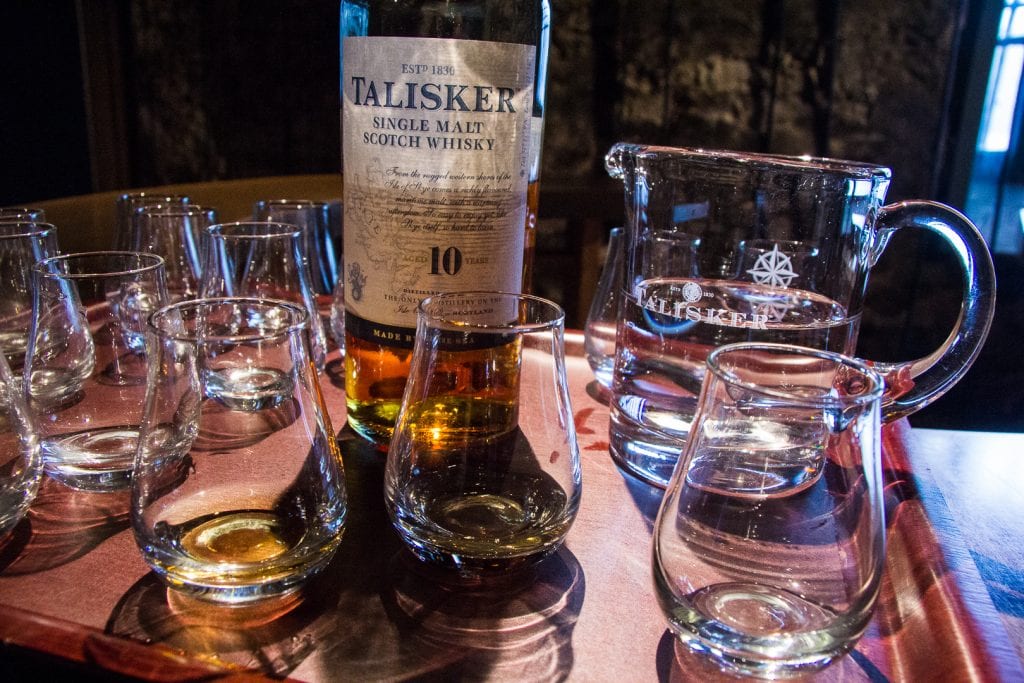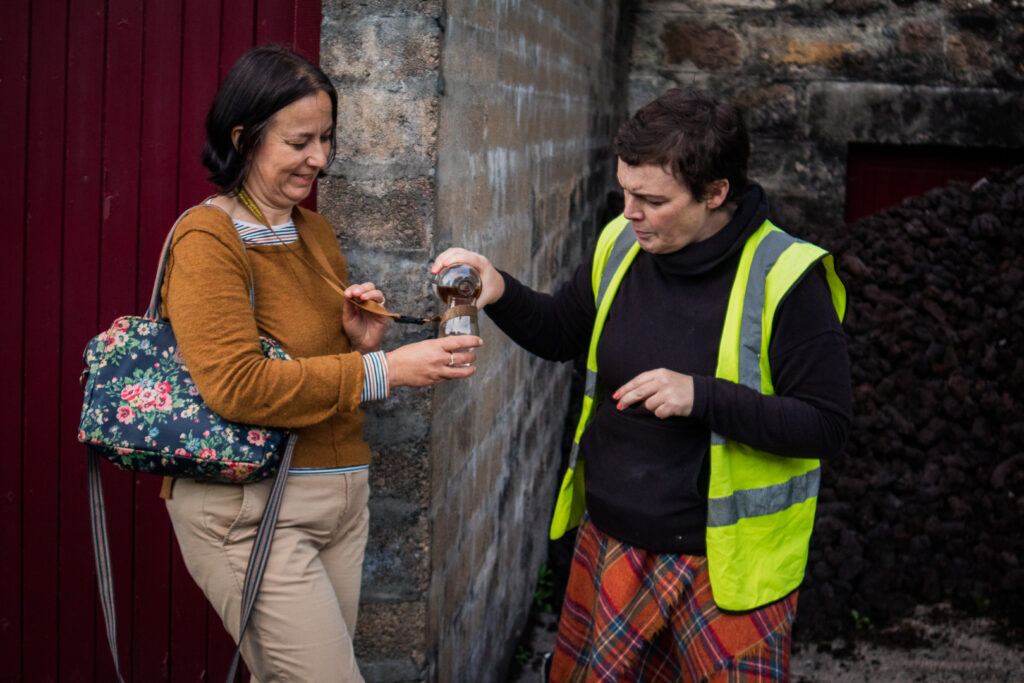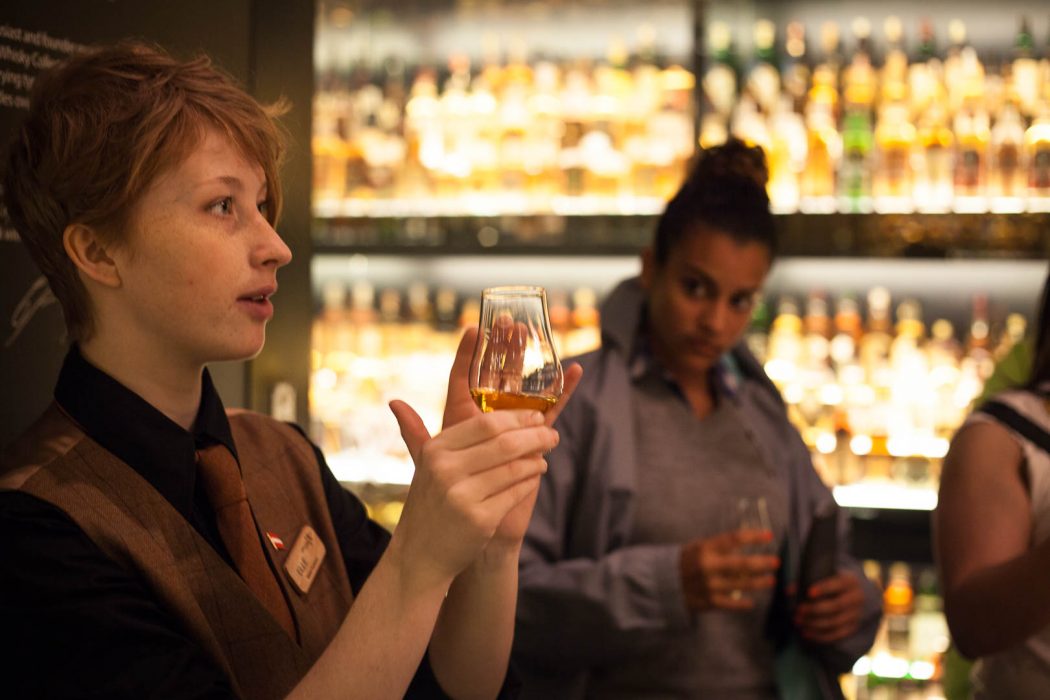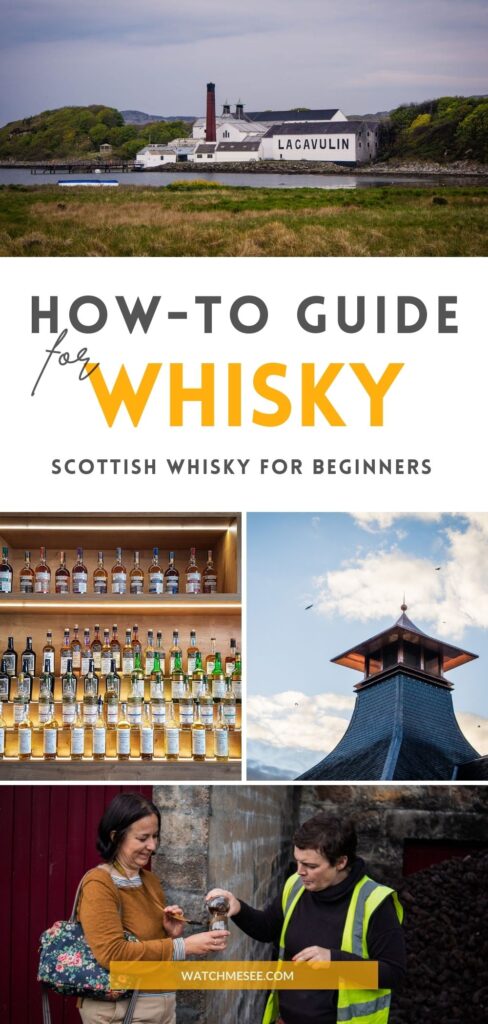Do you like whisky? If your answer is yes, then a trip to Scotland, the motherland of single malt whisky, should really be in your cards. If your answer is no, then you’re a lot like me – at least until I found “my whisky”. And that’s what this guide is all about – Scottish whisky, where to learn about it and how to find the dram that turns you into a whisky-lover.
This post contains affiliate links from which I may make a commission. Find out more here. All opinions are my own.
Then I moved to Scotland, I did not like whisky at all. But I knew that I had to give Scotland’s national drink a try. It took a few years, many distillery tours and even more drams, but I’ve finally fallen in love with it.
You can listen to my journey as a whisky-drinker on my podcast Wild for Scotland.
Whether you are already a connoisseur, or still green behind your ears like I was when I arrived in Glasgow, a trip to Scotland would not be complete without a Scottish whisky experience of some sort.
This trip contains:
- A brief FAQ about Scottish whisky
- Where to learn about the art of whisky distilling (apart from distilleries)
- How to order whisky in a pub
- Some popular whisky regions to visit
- Whisky festivals to attend
- Where to buy whisky as a souvenir
Table of Contents
Scottish Whisky FAQ
Whisky or Whiskey
Scottish whisky is spelled without the ‘e’. Whiskey (with the ‘e’) comes from Ireland. But while I think it’s important to get the spelling right when speaking about Scottish whisky, the process of how they are made are pretty much the same.
Another popular term that is used around the world is ‘Scotch’ – only it’s not used in Scotland at all. You might as well carry a sign that says tourist ? It’s not offensive to call Scottish Whisky scotch, but when you do, people immediately know you’re not from here.
Whisky regions
Scotland has five major whisky regions:
- Lowlands,
- Highlands (including all islands apart Islay),
- Speyside,
- Campbeltown and
- the Isle of Islay.
Some regions are well-known to produce whisky from peated (or smoked) barley – for example Islay. These drams have a very smoky smell & taste. Other regions produce whisky from air-dried barley, so they’re not smoky at all – Speyside whiskies are often considered easier to drink for beginners.
There are other differences between the regions too – from the local history of distilling, to the water and air quality that impact the taste. Once you’ve figured out whether you’re the smoky type or not, you’re already one step closer to finding a Scottish whisky you like.
Types of whisky
There are two types of whisky produced in Scotland – blended and single malt. Blended whisky is a whisky that is made up of different kinds of single malt from different distilleries.
Single malt whisky is generally sourced from one distillery, but few people know that single malt whisky is often still a combination of various whiskies from that single distillery.
If you want a whisky that is not mixed together with others, look for a cask bottlings.
Ageing
Scottish whisky must be aged in wooden casks for at least 3 years and one day. Otherwise it must not be called Scottish whisky. Many distilleries age their whiskies longer than that.
When you store alcohol in a wooden cask, some of the alcoholic vapours evaporate over time. That means that the longer you age a whisky, the less whisky will be in the cask, and the less alcoholic it will be.
When a single malt consists of several whiskies from a single distillery, it usually says the age of the youngest cask on the bottle, but there might be older whisky in the mix.
Age doesn’t necessarily indicate the quality or the taste of a whisky. There is very good whisky that has only aged a few years, and there is “old” whisky that isn’t all that exciting. Increasingly, more and more distilleries release special expressions without the age on the bottle.
Most whisky is aged and watered down before bottling to achieve a consistent alcohol level for commercial sales – usually around 40-45% abv. If you want to taste whisky as it comes out of the cask, look for cask-strength bottlings which are often upwards of 60% abv.
Whisky Casks
All Scottish whisky is aged in wooden casks – most of them are used bourbon casks from America or used Sherry casks from Spain. Nowadays, many distilleries experiment with all kinds of casks though – red wine, rum, port and more.
The art of making casks is called coopering. There are several cooperages around Scotland, who build and fix whisky casks to be used by distilleries.
The wood from the used casks gives the whisky its colour and adds flavour to the spirit. That said, many commercial distilleries add food colouring to their whiskies to achieve consistent colour results for commercial sales.
Where to learn about Whisky
The Scotch Whisky Experience in Edinburgh
The Scotch Whisky Experience in Edinburgh is a great place to learn about Scottish whisky, the process of making it and the differences between regions.
You still get a step-by-step explanation of the distilling process and a guided tasting with an expert.
for the first time this summer – almost three years into my time in Scotland. I thought that because it is not an actual distillery, it’s a tourist trap. Instead I visited three Highland distilleries and emerged from each of them even further away from the ultimate goal of liking whisky. But my trip to the Scotch Whisky Experience changed everything.
The Scotch Whisky Experience may not be a distillery and you will not be able to see those iconic copper stills, but for a complete beginner, I think it’s is the perfect introduction to Scottish whisky.
Based on the information you get here, you can make an educated choice of which whisky you’d like to taste – and I kid you not, this was the first time in my life that I a) enjoyed a whisky, and b) finished my entire dram.
Listen ‘An Acquired Taste’ – my Scotland travel podcast about the Speyside!
Visiting Whisky Distilleries
Once you’ve found your favourite Scottish whisky it makes sense to see where it comes from.
I’d like to think that visiting your first whisky distillery should be as meaningful as Ron Swanson from Parks & Rec visiting the Lagavulin distillery on the Isle of Islay. In reality I know this is probably not how it will go down, and most likely you will – just like me – choose to visit a distillery which is practically located along your chosen route through Scotland.
You can find whisky distilleries all over Scotland, and many of them are open for tours which usually cost between £10 and £30. Whether you travel to a specific distillery, or visit one along the way it is a great opportunity to learn more about one specific single malt whisky.
Most distillery tours include a guided tasting of at least one dram (although many include more) and a walk through the production facilities. Many also offer special tours from extended tasting options, to chocolate pairings, or walks with the distillery master for an additional peak behind the scenes. These are usually more expensive and more exclusive.
Some of my favourite whisky distillery tours include:
- Clydeside Distillery in Glasgow
- Glengoyne Distillery near Loch Lomond
- Oban Distillery in Oban
- Glen Scotia Distillery in Campbeltown
- Ardbeg Distillery on Islay
- Kilchoman Distillery on Islay
- Jura Distillery on Jura
- Aberlour Distillery in Aberlour
- Glenfiddich Distillery in Dufftown
- GlenDronach Distillery in Huntly
- Edradour Distillery near Pitlochry
The oldest working distillery in Scotland is the Glenturret distillery near Crieff – home of the Famous Grouse Whisky!
Note that in most distilleries you are not allowed to take photos or use your mobile phone inside the distilling area. Because of the alcohol in the air, you’d risk to blow up the entire place! Your guide will make you aware of this at the beginning of your tour, so please respect this!
Usually your tasting takes place in a separate room (always close to or even in the shop), so you can take photos there.

How to Order a Dram in a local Pub
Another way to find a whisky for your taste is to jump into the cold water and simply order one in a pub. I think you can judge the quality of a bar (wo)man by their ability to talk about whisky.
When you walk into a whisky pub, simply ask the bar staff for their recommendations, or go straight for the malt of the month, which is a very common special deal offered in most pubs. The malt of the month will most likely be a Scottish whisky at a reduced prize.
Once you have decided on your whisky, there are some rules as to how to order it – and I want you to repeat after me: “no ice“.
Scottish bar staff might forgive you for ordering ice when you’re not Scottish yourself, but they will encourage you to try the whisky on its own before tampering with it.
After trying it neat, your next step would be to add a few droplets of water, which releases more flavours and makes it easier to drink. Pubs usually have a jug of water on the bar which is there for exactly this purpose. If you still struggle, the bar staff will be happy to serve you some ice to add.
One thing you probably shouldn’t do is to order a single malt whisky with a mixer like coke. I think no one would forgive you even if you’re not Scottish. When you order a whisky and ginger ale, for example, it will usually be made with blended whisky or Irish whiskey.
That said, whisky cocktails are becoming more and more popular!
Finally, when it comes to drinking your dram, you should do it with leisure and enjoyment. It’s not tequila or vodka, so no need to rush!
Great whisky pubs in Scotland
There are many amazing whisky pubs in Scotland – but here are a few of my favourites:
- The Pot Still in Glasgow
- Ben Nevis Bar in Glasgow
- The Ballygrant Inn on Islay
- The bar at the Ardshiel Hotel in Campbeltown
- The Mash Tun in Aberlour
- The Quaich Bar at the Craigellachie Hotel in Craigellachie
- The Flying Stag at the Fife Arms Hotel in Braemar
- The Keys Bar in St Andrews


Cask-strength Aberlour served over water
Visiting Scottish Whisky Regions
There are whisky distilleries all over Scotland, but if whisky is the reason for your trip, it’s nice to visit places that have many distilleries in a fairly small area.
Two such locations are the Speyside in the northeast of Scotland and the Isle of Islay on the west coast.
Plan the ultimate whisky trip with my ready-made Scottish Whisky Itinerary!
Isle of Islay
The Isle of Islay is a relatively small island with only 3,000 inhabitants. But it’s also home to 9 distilleries (soon to be 10)! Islay whisky is known to be peaty, but there are also Islay distilleries who produce non-peated whisky (for example, Bruichladdich).
My top tip is to join the Islay tour with Rabbie’s and let someone else do the driving. Read my review here!
From Islay, you can. easily hop across to the Isle of Jura to visit the distillery there, or explore the Campbeltown whisky region further down the Kintyre peninsula.
Speyside
The Speyside is the most productive whisky region in Scotland. There are over 50 distilleries here, including the three largest distilleries in Scotland – Glenfiddich, Glenlivet and Macallan.
You can base yourself in Grantown-on-Spey, Aberlour, Craigellachie or Dufftown to explore the area. My top tip is to hire a local guide, so you don’t drink & drive, or join a distillery walking tour in Dufftown.
If you had enough whisky, you can visit the Speyside Cooperage, hike in the Cairngorms National Park or explore the many castles and historic sites in the area. Plan your trip with my Speyside travel guide.

Whisky Festivals in Scotland
There are several whisky festivals in Scotland, lasting from single days to more than a week. The two most famous whisky festivals happen in the SPeyside and on the Isle of Islay.
Fèis Ìle
Fèis Ìle is the Islay Festival of Malt and Music and has been held since 1986. All the distilleries on the island are involved and in addition to the festival programme of music and dance, each distillery offers a programme of things to do throughout the festival.
Fèis Ìle happens at the end of May and the beginning of June and lasts 9 days. Note that it’s essential to book accommodation and ferry tickets far in advance. Read my full Fèis Ìle festival guide.
Spirit of Speyside
The Spirit of Speyside Whisky Festival celebrates the whisky of the Speyside region. The distilleries come together to offer hundreds of events for whisky lovers.
Spirit of Speyside happens at the end of April and lasts around 6 days.
Buying Whisky as a Souvenir
You can buy whisky basically anywhere. Every supermarket and off-license shop sells at least a small selections of blended whisky and single malts (only from 10am to 10pm though). However, to get a specific Scottish whisky brand or a malt of a certain age, you will have to go to a special whisky shop.
In Edinburgh and Glasgow there are several whisky shops around the city centres. I like The Whisky Shop at Buchanan Galleries or The Good Spirit Co on Bath Street in Glasgow, and The Whisky Shop on Victoria Street in Edinburgh.
The Scotch Whisky Experience also has a shop, and so has virtually every distillery with a visitor centre. There you can buy anything from the standard bottles starting at £30-35 (for 70cl) to the special editions and super-old bottles which can set you back hundreds or even thousands of pounds.
Some distilleries even allow you to fill your own bottle.
As a souvenir, I like bringing a small 5cl bottles which you can even get on a whim at the airport!
My days of despising Scottish whisky are long gone. I went from not liking it to preferring the peaty whiskies from Islay.
I hope this guide makes you excited about trying Scottish whisky yourself!
Pin this post for later:









Pingback: 'An Acquired Taste' - Isle of Islay - Wild for Scotland
Scottish drinks have always been my favourite. I have always struggled with which one to get when I am at the supermarket, or a bar, or a club. This blog has provided me with a guide always to get the right drink when I am buying one!
Great article! Perhaps do a “part 2” as you discover more whisky that you enjoy. I have come to the place where I know I don’t like the Peaty(?) taste. Which is smoky flavored (?), kind of like what you experience when you smell a cigar, I suppose. I like it smooth whisky. Have been trying the little bottles so I can try different ones until I find the one I really, really like. Then I will spring for a regular bottle. And this is the best way to try ones that if you don’t like them so much you haven’t spent all your coin and then stuck with a bottle you are thrilled with. Planning on coming to Scotland this year. So thank you for the suggestion of the Whiskey Experience. Very helpful!
That would be fun actually! I have learnt a lot in the ast two years and my taste in whisky has changed a lot! The problem with the small bottles is often, that you don’t get the more unusual whiskies in them. I like tasting different ones at airports, or as I say in the article either in a really good whisky pub or a shop where you get great recommendations. Hope you have a great trip!
Pingback: The Classic Scotland Itinerary for One Week | Watch Me See
Pingback: A Day Trip to Stirling Castle and Loch Lomond with Rabbie's
Pingback: Day Trips from Glasgow: Visiting Glengoyne Distillery
Pingback: My Off-Beat Scotland Bucket List for 2017 | Watch Me See
Pingback: A Day Trip to Loch Ness with Rabbie's | Watch Me See
Pingback: 50 Useful Travel Tips for Scotland | Watch Me See
After reading this post I was thinking “Did we ever have a single whisky together, during our careers as barwomen?” But I think we really haven’t…I mean, we are not talking about gin, right? 😉 I really like your blog and always enjoy reading it.
Haha I just remember always sneaking coke into my Lagavulin when someone bought be one… Probably shouldn’t write this in public 🙂
Ahaha amazing face when you’re trying the whiskey! I love whiskey but it’s also like my kryptonite 😉 Clearly I need to go to Scotland and see what the real stuff is like!
I’m trying so hard to like it, but it’s not easy… If you’re into whiskey, you totally have to come here! It’s the real thing 🙂
Loved this post! Definitely keeping it for my future trips to Edinburgh (:
Camilla | http://cammi.dk
Thanks for your comment! Definitely put the Scotch Whisky Experience on your list!!
Ah, amazing! I too really enjoyed the Scotch Whisky Experience in Edinburgh and went for the Speyside whiskey too – it was great! Glad I’m not the only one who was converted!
Haha amazing! Yeah, it took a lot of convincing for me… But last weekend I actually had my first proper whisky – like chose and ordered it in a pub myself, finished the whole thing AND enjoyed it 🙂